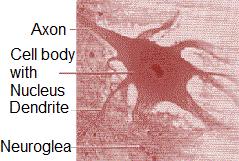The Neural tissue
Neural tissue exerts most control over the body's response to changing conditions. Neurons are the excitatory cells and the unit of the neural system.
Neuroglea make up more than onehalf the volume of neural tissue in our body.
When a neuron is suitably stimulated, an electrical disturbance is generated that rapidly travels along its plasma membrane.
Arrival of the disturbance at the neuron’s endings, or output zone, triggers events that may cause stimulation or inhibition of adjacent neurons and other cells

Dendrite
Dendrite is a highly branched processes and responsible for receiving information from other neurons and synapses. Information of other neurons is provided by dendrites to connect with its cell body.
Axon membrane
The axon membrane may be defined as the surface membrane of the axonal process from the point at which it emerges from the axon hillock of the neuronal perikaryon to the axonal terminal or nerve ending that forms a synapse on another cell.
Synapse
The junction between the axon of one neuron and the dendrite of another, through which the two neurons communicate.
Nerve fiber
The axon is also called nerve fibre. It is the portion of a nerve cell (neuron) that carries nerve impulses away from the cell body. A neuron typically has one axon that connects it with other neurons or with muscle or gland cells. Some axons may be quite long (from the spinal cord down to a toe).
